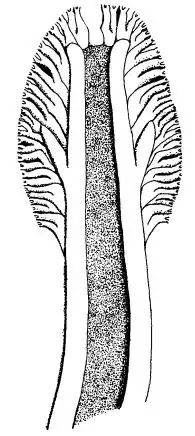| Gehlingia Temporal range: Ediacaran | |
|---|---|
 | |
| Artists reconstruction of Gehlingia dibrachida (note deep groove and tubular structures). Reconstruction from McMenamin and McMenamin, 1994, Hypersea: Life on Land modified by Heather Winkelmann. | |
| Scientific classification | |
| Domain: | Eukaryota |
| Kingdom: | Animalia |
| Phylum: | incertae sedis |
| Genus: | †Gehlingia McMenamin, 1998 |
| Species: | †G. dibrachida |
| Binomial name | |
| †Gehlingia dibrachida McMenamin, 1998 | |
Gehlingia dibrachida is a species of enigmatic Ediacaran organism from South Australia described in 1998. Gehlingia has been described as having many characteristics of petalonamids, although it has been classified as a rather close relative of the Tribrachidium.[1] The overall shape of Gehlingia contradicts this affinity, however, with its shape being a more Bilaterally symmetrical one although the basic structure similar to that of Tribrachidium appears in Gehlingia as separate branches extending into bifurcating minor branches[1] along with "thumb structures" that are apparent in Tribrachidium in the form of side bulges on an axis.[2]
Etymology
The generic name honours the Australian palaeontologist specialising in Ediacaran fossils, James G. Gehling.[2]
Description
Gehlingia dibrachida represents a frond-like bilaterally symmetric organism with two fronds with each half of them having a swollen axis on an inner edge. The organism's axis bifurcated once and bifurcates towards the outer edge of its two fronds.[3] Similar deformations occur in both Tribrachidium and Gehlingia some notable ones being delaying of the bifurcation and tubular structures being visible between the striae. A number of tubular structures emanate from the axis and are often either straight or curved.[3] A deep groove separates the two axes. The entire animal is estimated to have been 8 centimeters (3.1 in) in length and 3.1 centimeters (1.2 in) in width.[3] The tubular structures of the two "fronds" end abruptly and in turn form a smooth edge to the organism.[3]
In Gehlingia (as well as Tribrachidium) there are "thumb" structures that appear to have been positioned on the left and right side of the main branch.[1] In Tribrachidium, the thumb structures are visible as side bulges which extend out of an axis.[2]
Further reading
See also
References
- 1 2 3 Dynamic Paleontology: Using Quantification and Other Tools to Decipher the History of Life. Springer. 10 June 2016. ISBN 9783319227771.
- 1 2 3 The Garden of Ediacara: Discovering the First Complex Life. Columbia University Press. 1998. ISBN 9780231105583.
- 1 2 3 4 Fedonkin, Mikhail A.; Sciences), Mikhail A. (Head Fedonkin, Laboratory of Precambrian Organisms Russian Academy of; Gehling, James G.; Museum), James G. (Senior Curator Gehling, retired 6 27 2019 South Australian; Grey, Kathleen; Narbonne, Guy M.; Vickers-Rich, Patricia; University), Patricia (Director Vickers-Rich, Monash (Mar 16, 2007). The Rise of Animals: Evolution and Diversification of the Kingdom Animalia. JHU Press. ISBN 9780801886799. Retrieved May 11, 2022 – via Google Books.
{{cite book}}: CS1 maint: multiple names: authors list (link) CS1 maint: numeric names: authors list (link)